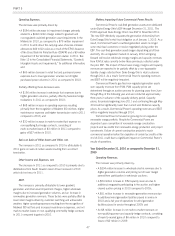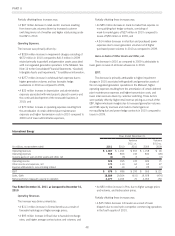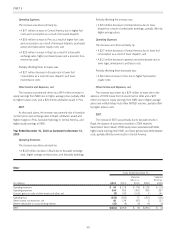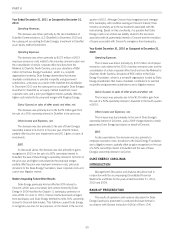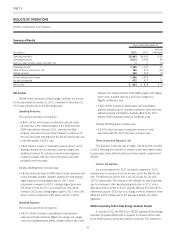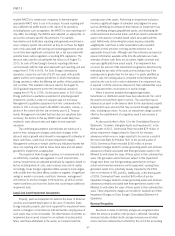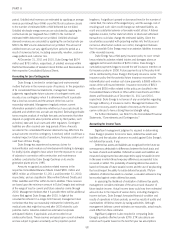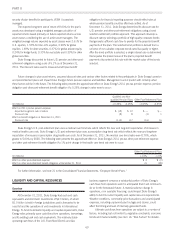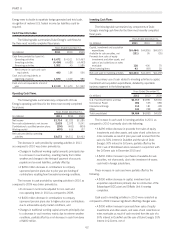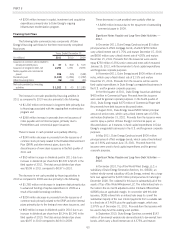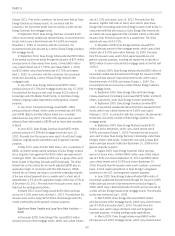Duke Energy 2011 Annual Report Download - page 77
Download and view the complete annual report
Please find page 77 of the 2011 Duke Energy annual report below. You can navigate through the pages in the report by either clicking on the pages listed below, or by using the keyword search tool below to find specific information within the annual report.
PART II
implied WACC’s for certain peer companies in determining the
appropriate WACC rates to use in its analysis. As each reporting unit
has a different risk profile based on the nature of its operations,
including factors such as regulation, the WACC for each reporting unit
may differ. Accordingly, the WACCs were adjusted, as appropriate, to
account for company specific risk premiums. For example,
transmission and distribution reporting units generally would have a
lower company specific risk premium as they do not have the higher
level of risk associated with owning and operating generation assets
nor do they have significant construction risk or risk associated with
potential future carbon legislation or pending EPA regulations. The
discount rates used for calculating the fair values as of August 31,
2010, for each of Duke Energy’s domestic reporting units were
commensurate with the risks associated with each reporting unit and
ranged from 5.75% to 9.0%. For Duke Energy’s international
operations, a base discount rate of 8.2% was used, with specific
adders used for each separate jurisdiction in which International
Energy operates to reflect the differing risk profiles of the jurisdictions
and countries. This resulted in discount rates for the August 31,
2010 goodwill impairment test for the international operations
ranging from 9.7% to 13.0%. As discussed above, in 2011 Duke
Energy performed a qualitative assessment of potential goodwill
impairment, and thus a step one valuation was not necessary.
Management’s qualitative assessment took into consideration the
decline in 2011 of a key input to the WACC calculation; namely, a
decline in the current risk-free rate on twenty year U.S. Treasury
bonds. Management concluded that had step one valuations been
necessary, the decline in this key WACC input would likely have
resulted in lower discount rates and higher income approach
valuations.
The underlying assumptions and estimates are made as of a
point in time; subsequent changes, particularly changes in the
discount rates or growth rates inherent in management’s estimates of
future cash flows, could result in future impairment charges.
Management continues to remain alert for any indicators that the fair
value of a reporting unit could be below book value and will assess
goodwill for impairment as appropriate.
The majority of Duke Energy’s business is in environments that
are either fully or partially rate-regulated. In such environments,
revenue requirements are adjusted periodically by regulators based on
factors including levels of costs, sales volumes and costs of capital.
Accordingly, Duke Energy’s regulated utilities operate to some degree
with a buffer from the direct effects, positive or negative, of significant
swings in market or economic conditions. However, management
will continue to monitor changes in the business, as well as overall
market conditions and economic factors that could require additional
impairment tests.
Long-Lived Asset Impairment Assessments
Property, plant and equipment is stated at the lower of historical
cost less accumulated depreciation or fair value, if impaired. Duke
Energy evaluates property, plant and equipment for impairment when
events or changes in circumstances indicate that the carrying value of
such assets may not be recoverable. The determination of whether an
impairment has occurred is based on an estimate of undiscounted
future cash flows attributable to the assets, as compared with the
carrying value of the assets. Performing an impairment evaluation
involves a significant degree of estimation and judgment in areas
such as identifying circumstances that indicate an impairment may
exist, identifying and grouping affected assets, and developing the
undiscounted and discounted future cash flows (used to estimate fair
value in the absence of market-based value) associated with the
asset. Additionally, determining fair values requires probability
weighting the cash flows to reflect expectations about possible
variations in their amounts or timing and the selection of an
appropriate discount rate. Although cash flow estimates are based on
relevant information available at the time the estimates are made,
estimates of future cash flows are, by nature, highly uncertain and
may vary significantly from actual results. If an impairment has
occurred, the amount of the impairment recognized is determined by
estimating the fair value of the assets and recording a loss if the
carrying value is greater than the fair value. For assets identified as
held for sale, the carrying value is compared to the estimated fair
value less the cost to sell in order to determine if an impairment loss
is required. Until the assets are disposed of, their estimated fair value
is re-evaluated when circumstances or events change.
When it becomes probable that regulated generation,
transmission or distribution assets have been abandoned, the cost of
the asset is removed from plant in service. The value that may be
retained as an asset on the balance sheet for the abandoned property
is dependent upon amounts that may recovered through regulated
rates, including any return. As such, an impairment charge could be
offset by the establishment of a regulatory asset if rate recovery is
probable.
As discussed further in Note 12 to the Consolidated Financial
Statements, “Goodwill, Intangible Assets and Impairments”, in the
third quarter of 2011, Commercial Power recorded $79 million of
pre-tax impairment charges related to Clean Air Act emission
allowances which were no longer expected to be used as a result of
the new Cross State Air Pollution Rule. In the second quarter of
2010, Commercial Power recorded $160 million of pre-tax
impairment charges related to certain generating assets and emission
allowances primarily associated with these generation assets in the
Midwest to write-down the value of these assets to their estimated fair
value. The generation assets that were subject to this impairment
charge were those coal fired generating assets that do not have
certain environmental emissions control equipment, causing these
generation assets to be potentially heavily impacted by the EPA’s
rulesonemissionsofNO
xand SO2.Additionally,inthethirdquarter
of 2009, Commercial Power recorded $42 million of pre-tax
impairment charges related to certain generating assets and emission
allowances primarily associated with these generation assets in the
Midwest to write-down the value of these assets to their estimated fair
value. These impairment charges are recorded in Goodwill and Other
Impairment Charges on Duke Energy’s Consolidated Statement of
Operations.
Revenue Recognition
Revenues on sales of electricity and gas are recognized when
either the service is provided or the product is delivered. Operating
revenues include unbilled electric and gas revenues earned when
service has been delivered but not billed by the end of the accounting
57


